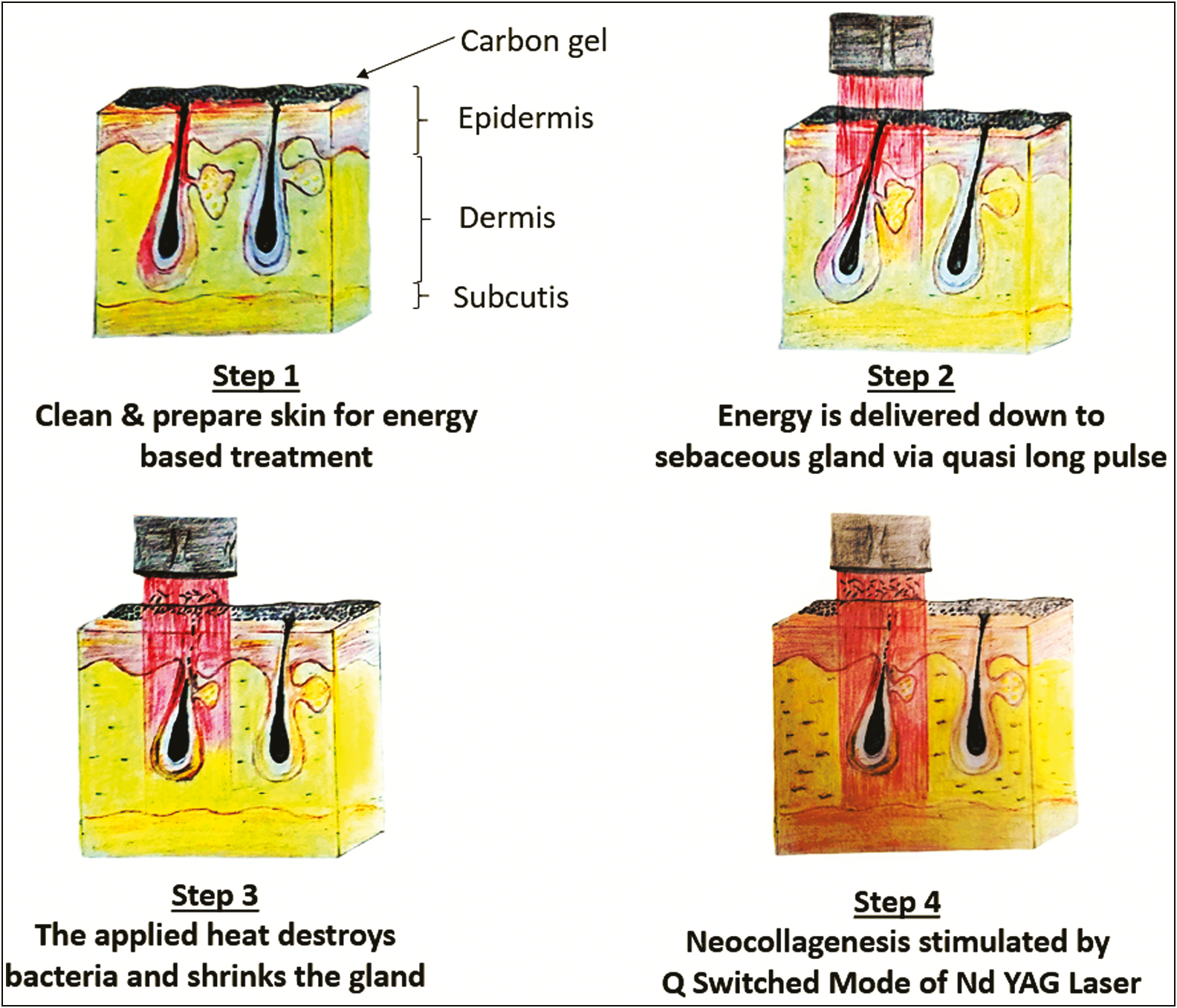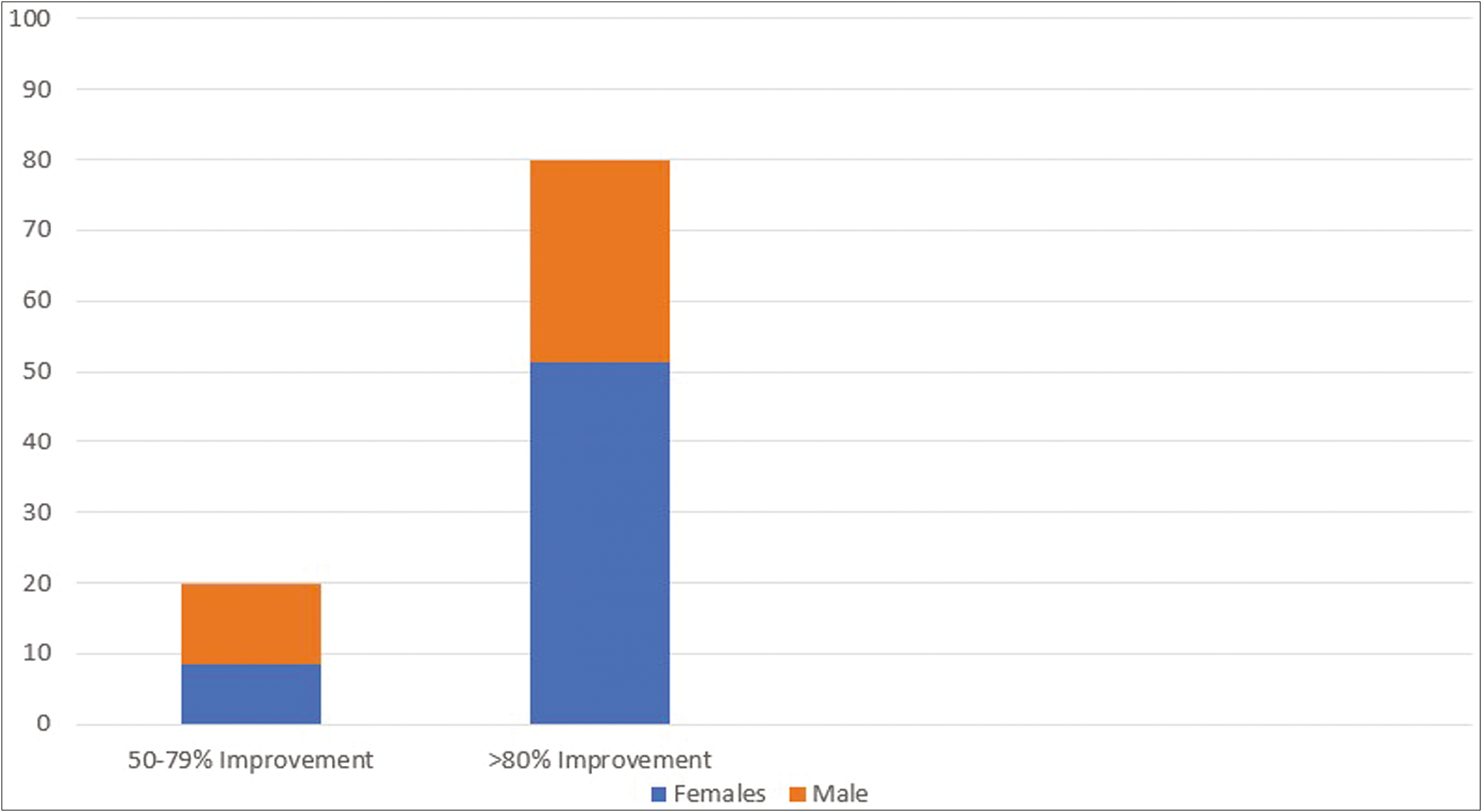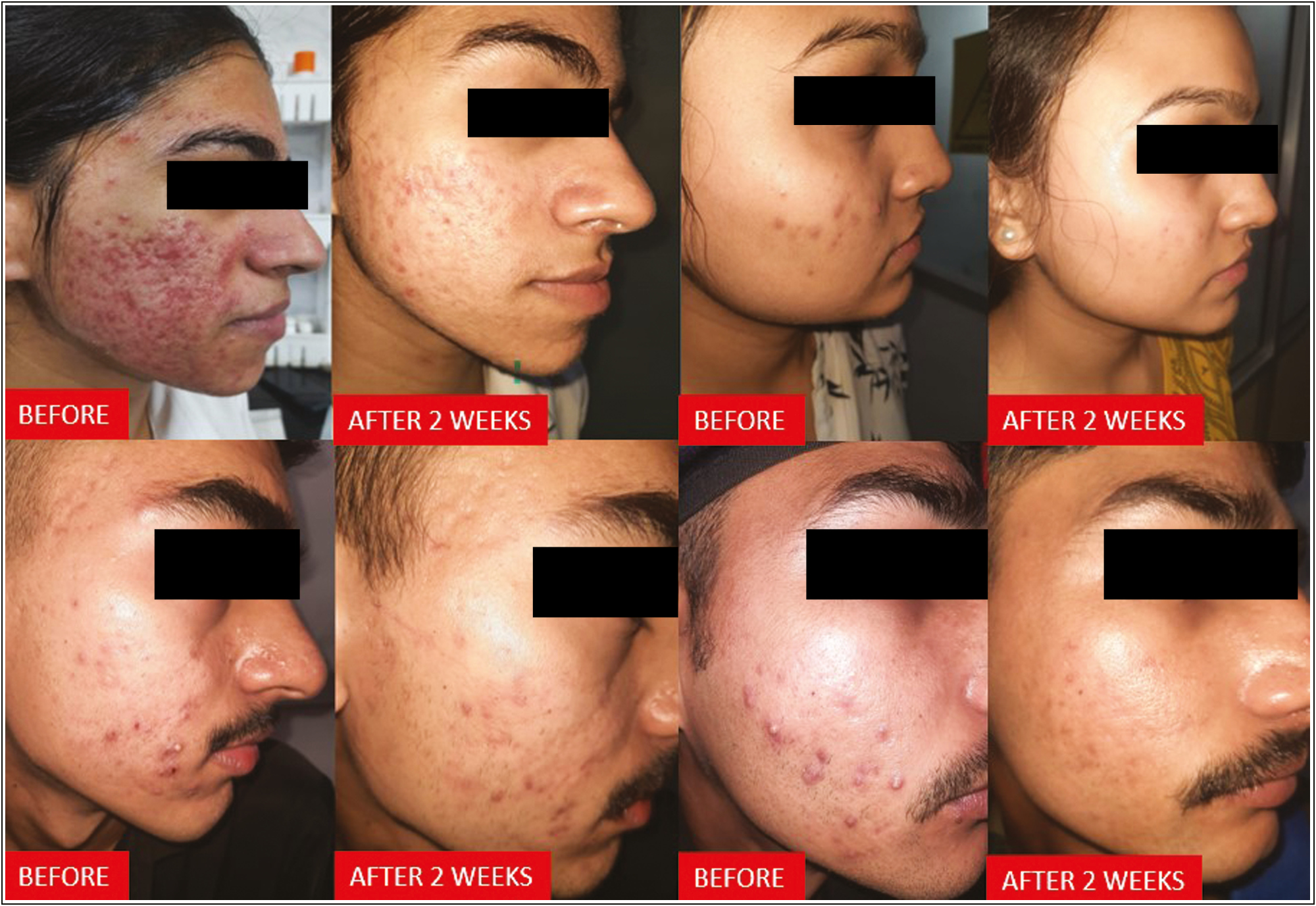Translate this page into:
Efficacy of Carbon Peel Laser in Acne Vulgaris in Skin of Color: A Single Center Prospective Study
Address for correspondence: Dr. Anuj Bhatnagar, MD, Department of Dermatology, Command Hospital Air Force, Old Airport Road, Agram Post, Bangalore, Karnataka, India. E-mail: debdeep5000@gmail.com
This article was originally published by Wolters Kluwer - Medknow and was migrated to Scientific Scholar after the change of Publisher.
Abstract
Abstract
Background:
Acne vulgaris is a chronic disease of pilosebaceous units that affects approximately 80% of adult population. Despite various treatment modalities being reported, treating acne with minimal side effects is difficult. Specifically, topical carbon suspension combined with QsNdYAG laser treatment (carbon peel laser technique) has gained popularity recently for effective treatment of acne vulgaris.
Objectives:
To study the efficacy of carbon peel laser technique in the management of acne vulgaris (Grade II–IV) in skin of color.
Materials and Methods:
A prospective observational study was done on 35 patients who presented with acne vulgaris Grade II–IV, who were poorly compliant to treatment with topical/systemic agents owing to side effects or failure of treatment, to meet patient’s expectations. The patients were subjected to an initial topical application of carbon suspension (Cosderma Carbon gel) followed by treatment with quality switching neodymium yttrium aluminum garnet (Qs:NdYAG) laser in two modes (quasi long pulsed mode followed by Q switched mode 1064 nm). The treatment consisted of three sittings with intervals of 2 weeks. The patients were asked to avoid use of any topical/systemic medication for acne during this period.
Results:
Significant reduction of erythematous and nodular acne lesions was noted after three sittings of “carbon peel laser technique”. Among 35 patients, 28 (80%) showed >80% improvement and 7 (20%) showed 50%–80% improvement in skin lesions in the form of decrease in the number and size of lesions and extent of inflammation, with no patients nonresponsive to treatment. The postprocedure complications were minimal; 6 (20%) developed erythema, and 1 (3.3%) patient developed mild tolerable pain with no post inflammatory hyper/hypopigmentation. The postprocedure mean ISGA (Investigator Status Global Assessment) was 1.342 as compared with preprocedure mean ISGA of 3.657 with value of P <0.0001.
Conclusion:
Carbon peel laser technique is an effective method for the management of acne vulgaris in skin of color with minimal side effects and significant results
Keywords
Acne vulgaris
carbon peel
Qs NdYAG laser
INTRODUCTION
Acne vulgaris is a common inflammatory skin disorder that affects nearly 85% of adolescents and young adults. It has a multitude of factors contributing to its pathogenesis such as pilosebaceous duct hyperkeratinization, ductal colonization with Propionibacterium acnes (P. acnes), increased sebum production, hormonal factors, and diet. Furthermore, there has recently been an increased emphasis on the role of chronic inflammation and inflammatory cytokine cascades in the pathogenesis of acne.[1]
Topical and oral antibiotics, topical keratolytic, hormonal agents, and topical and oral retinoids are among the traditional treatments for acne vulgaris.[2] Alternative therapies have emerged due to increased resistance to traditional treatment options, as well as undesirable side effects. Many laser and light-based acne treatment devices have shown promising results and have paved way for a new modality for treatment of acne.[3] The precise mechanism of action of these devices in the treatment of acne is unknown, but it is most likely due to the generation of photothermal and/or photochemical reactions, which have a positive impact on the pilosebaceous unit and its influencing factors.[4]
Carbon peel laser technique or “Hollywood peel” (the popular Internet term) has been trending on social media as the latest technology in cosmetology for management of oily skin, uneven skin tone, facial wrinkles, and acne vulgaris. This technique works on the principle of skin penetration of an applied carbon solution into the pilosebaceous unit and this acts as an external chromophore for the absorption of laser energy as shown in Figure 1. The long pulse mode of laser energy initially exposed to skin acts in heating up the carbon particles. Subsequently, the quasi mode pulse creates thermal energy which causes the therapeutic effect. The thermal effect is put into use in causing destruction of the organism Propionibacterium acnes and also atrophy of sebaceous glands causing decreased sebum production for treating acne. The technique can also be used in managing photo ageing and facial wrinkles by stimulating collagen synthesis. This laser modality is also food and drug administration approved for management of melasma by causing selective destruction of melanocytes which contain melanin that acts as a chromophore. However not much scientific literature is available regarding the efficacy of this method in managing acne vulgaris and its advantage in cases not responding to topical/systemic therapy with potential side effects. The aim of this study is to evaluate the efficacy and safety of the “carbon peel laser technique” in the management of acne vulgaris in skin of color.

- Diagrammatic representation of the mechanism of action of carbon peel
MATERIALS AND METHODS
A prospective randomized control trial was carried out during the period of October 2021 to April 2022. The subjects were recruited from the patients of acne vulgaris attending the outpatient department of our dermatology department. The study protocol was approved by the Research Ethical Committee of our center and all participants in the study were explained about the procedure and written informed consent was taken for the same.
Inclusion criteria
All diagnosed cases of acne vulgaris (Grade II–IV) above 18 years of age. All de novo and treatment-resistant cases were included.
Exclusion criteria
Pregnant and lactating women and patients who have received prior isotretinoin therapy within the last 6 months.[4]
A detailed history was taken and clinical examination was done before including the participants in the study. Patients were instructed not to use any systemic, topical, or phototherapy-based acne treatment 2 weeks before the first session and throughout the whole course of therapy and follow-up evaluations. Before each session, the patient’s face was thoroughly cleansed with soap and water following which a topical carbon gel (Cosderma carbon gel) was applied over the entire face and left for 20–25 min to allow the penetration of the carbon particles into the pilosebaceous unit and epidermis. Later excess carbon gel, if any, was removed using cotton gauze. Following this the patient was subjected to neodymium yttrium aluminum garnet (NdYAG) laser (1064 nm) energy in two modes: initially long pulsed (Genesis Mode-microseconds) and later by quality switched mode (nanoseconds) with fluence varying from 1.5 to 2.5 J/cm2 and spot size of 10 mm for a period of 5 min. After the session, patient was advised daily application of a hypoallergenic UVA/B sunscreen with SPF 50. A total of three sessions were done at 2 weekly intervals. Clinical assessment and digital photography were conducted at baseline before each session using identical camera settings and lighting conditions. Final assessment was made 2 weeks after last session on the basis of Investigator Static Global Assessment (ISGA) scale having six levels from Grade 5 (severest) to Grade 0 (clear) and self-satisfaction assessment scale by patients in term of resolution of lesion (grading from 0%–100%). Patients were assessed for adverse effects if any on each session, by asking if they had experienced any problems such as pain, erythema, oedema, exudation, pin-point bleeding, crusting, hyperpigmentation, hypopigmentation, and acneiform eruption.
RESULTS
All data were collected, tabulated, and analyzed using SPSS version 20.0 (IBM SPSS Statistics for windows, version 20.0. Armonk, NY: IBM Corp) and Microsoft Excel 365. A P-value <0.05 was considered as statistically significant. A total of 35 patients were studied, out of which 21 were women and 14 were men. They belonged to the age group of 18–35 years with mean age of 26.5 years. Out of 35 subjects, the following were the numbers in each grade of acne vulgaris: 11 (Grade IV), 23 (Grade III), and 1 (Grade 2). The ISGA grade was assessed pre- and posttreatment. The postprocedure mean ISGA was 1.342 as compared with preprocedure mean ISGA of 3.657 with P-value <0.0001. Among the study population, 28 (80%) showed >80% improvement and 7 (20%) showed 50%–80% improvement in skin lesions in the form of decrease in the number, size of lesions, and extent of inflammation as shown in Figures 2 and 3. It was noticed that none of the patients were nonresponsive to this treatment technique. The postprocedure complications were minimal; however, out of total 35, 6 (20%) developed erythema, 1 (3.3%) developed mild tolerable pain, and none developed postinflammatory hyper/hypopigmentation. Since the P-value of the comparison between ISGA pre- and posttreatment was less than 0.05 (<0.0001), which is significant, it is inferred that carbon peel laser technique is definitely a very effective modality for management of acne vulgaris in patients with skin of color with negligible side effects.

- Gender wise distribution of the improvement results

- Serial improvement in the patients with the before and after 2 weeks photographs for comparison
DISCUSSION
Acne vulgaris is one of the most common dermatologic diseases, affecting both teenagers and adults and having the potential to have long-term psychosocial and physical consequences.[5] Being a chronic inflammatory skin disorder, a long-term combination treatment as well as maintenance therapy is recommended for management of acne vulgaris. Traditional treatments, such as topical and oral medications, are frequently associated with poor adherence, a lack of long-term remission, and potential side effects. The complications of acne if left untreated are scarring, dyspigmentation, and physical discomfort. So prompt and safe treatment modality is the key to the management of this condition.[6]
Carbon peel laser technique was conceptualized in 1997 by Goldberg et al. for laser hair removal. After giving promising results due to its effect on hair follicles, the technique has extended horizons in treating acne vulgaris and minimizing skin pores.[7] This technique is popularly known as “Hollywood peel” due to its use as a leading anti-ageing treatment in Los Angeles by celebrities. Although the Q-switched 1064-nm Nd:YAG laser is not commonly used for acne treatment, careful manipulation of the beam parameters or combination with an exogenous artificial chromophore, such as topical carbon gel acting as a photo enhancer, has been linked to significant improvements in acne. This effect could be attributed to thermal influence of laser energy on the pilo-sebaceous unit and P. acnes, as well as a decreased cytokine-mediated inflammatory cascade, which is the key player in acne pathogenesis.[78] This technique has added advantage of causing neo-collagenesis resulting in improvement of skin texture and acne scar remodeling. Interestingly, the carbon peel laser technique also provides a peeling effect, exfoliating the skin surface and plugged pores, thereby correcting follicular epithelial hyper-cornification that blocks the physiologic outflow of sebum to the skin surface and reduces skin inflammation.[8] This technique has its perks of being absolutely painless, “lunch break procedure” with zero downtime. So it is preferable compared with the long-term systemic treatment for severe acne which comes with its own gamut of side effects. In our study, significant reduction of erythematous and nodular acne lesions was noted after two sittings of carbon peel laser technique 2 weeks apart. There were no serious side effects reported in our study. Among 35 study subjects, 6 (20%) developed erythema, 1 (3.3%) developed mild tolerable pain, and none developed postinflammatory hyper/hypopigmentation (which is a common side effect encountered in Asian skin). Although a lot of information is available on carbon peel laser technique in social media, we found that there is no scientific literature available regarding its efficacy on population with skin of color. Since the side effect profile of laser therapy also varies depending on ethnicity of skin, we felt it necessary to study the effect of this technique on Indian skin. The patients had showed marked improvement in acne with only this modality without any adjuvant topical/systemic therapy which makes the study unique.
CONCLUSION
Carbon peel laser technique is definitely a very effective treatment modality in management of acne vulgaris, which is severe and is nonresponsive to conventional treatment modalities. This technique can be used as a single tool for management of inflammatory acne. The technique has the benefit of not causing any postinflammatory hyper/hypopigmentation in the patients which is a very common adverse effect noticed in other surgical modalities for acne management (e.g., microneedling and dermabrasion). It is an ideal choice for young adults who are not willing to opt for long-term systemic therapy and expecting quick results. However, there is a requirement of further research with a larger sample size for validating the benefits for this technique and study the long-term follow-up results.
Declaration of patient consent
The authors certify that they have obtained all appropriate patient consent forms. In the form the patient(s) has/have given his/her/their consent for his/her/their images and other clinical information to be reported in the journal. The patients understand that their names and initials will not be published and due efforts will be made to conceal their identity, but anonymity cannot be guaranteed.
Financial support and sponsorship
Nil.
Conflicts of interest
There are no conflicts of interest.
References
- The prevalence of acne in adults 20 years and older. J Am Acad Dermatol. 2008;58:56-9.
- [Google Scholar]
- Evolving perspectives on the etiology and pathogenesis of acne vulgaris. J Drugs Dermatol. 2015;14: 263-72.
- [Google Scholar]
- Standard guidelines of care: Performing procedures in patients on or recently administered with isotretinoin. J Cutan Aesthet Surg. 2017;10:186-94.
- [Google Scholar]
- Prevalence, severity, and severity risk factors of acne in high school pupils: A community-based study. J Invest Dermatol. 2009;129:2136-41.
- [Google Scholar]
- European evidence-based (S3) guidelines for the treatment of acne. J Eur Acad Dermatol Venereol. 2012;26(Suppl 1):1-29.
- [Google Scholar]
- Enlarged pores treated with a combination of Q-switched and micropulsed 1064 nm nd:YAG laser with and without topical carbon suspension: A simultaneous split-face trial. Laser Ther. 2011;20:181-8.
- [Google Scholar]
- Prospective randomized controlled clinical and histopathological study of acne vulgaris treated with dual mode of quasi-long pulse and Q-switched 1064-nm nd:YAG laser assisted with a topically applied carbon suspension. J Am Acad Dermatol. 2012;66:626-33.
- [Google Scholar]






